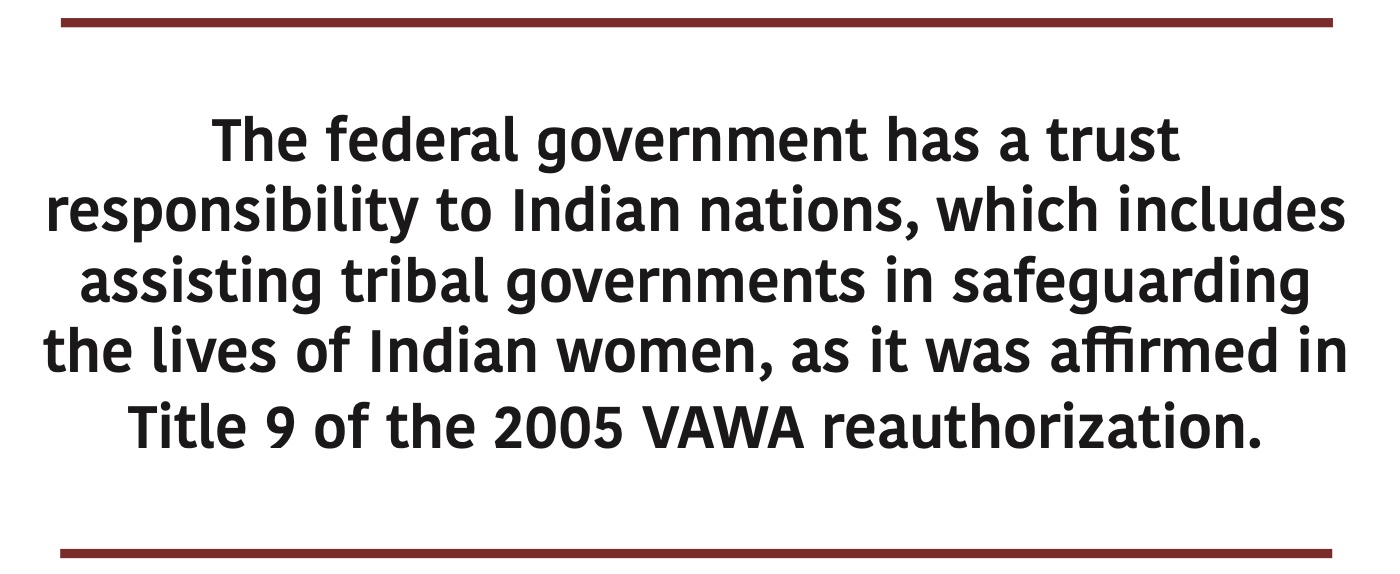Addressing the Crisis of Missing and Murdered Indigenous Women
National Legislative Reforms to Strengthen Sovereignty Are Essential

At NIWRC, we work to address violence against Indigenous women by lifting the voices of grassroots advocates, offering culturally-grounded resources, and providing technical assistance and training to Indian tribes and Native Hawaiians. We also work at a policy level to find and develop solutions for tribes in addressing gender-based violence. NIWRC has organized to raise awareness of missing and murdered Indigenous women (MMIW) on a national scale for the past decade.
The first MMIW case that we actively supported was Hanna Harris’ case, which was the catalyst for the May 5 Day of Awareness for Missing and Murdered Indigenous Women and Girls (MMIWG). For those of you that are not familiar with her story, in 2013, 21-year-old Hanna disappeared from her home in Lame Deer, Montana, which is also the home of NIWRC. Her body was found several days later by a volunteer search party after police failed to take the case seriously. Her case then went unsolved for nine months.
Hanna’s story is reflective of thousands of cases of missing and murdered Native women and children where insufficient resources, confusion over jurisdiction, and lack of police presence or response hampered efforts to recover victims quickly. These barriers reflect systemic disparities denying Indigenous women safety and justice, generation after generation.
The response to these systemic barriers requires a multi-level approach, rooted in tribal sovereignty. The NIWRC’s approach to MMIW is to strengthen the authority of and resources provided to Indian tribes and Native Hawaiian communities to protect the lives of Indigenous women. We, therefore, advocate for:
- restoring jurisdiction to handle cases at the local, tribal level through the reauthorization of the Violence Against Women Act (VAWA);
- providing adequate resources for tribal victim services through the Family Violence Prevention and Services Act (FVPSA) and the Victims of Crime Act; and,
- removal of systemic barriers, such as improving access to federal criminal databases and establishing a standard protocol to respond to MMIW cases through the implementation of Savanna’s Act and the Not Invisible Act in consultation with tribes, advocates, survivors, and families.
The federal government has a trust responsibility to Indian nations, which includes assisting tribal governments in safeguarding the lives of Indian women, as it was affirmed in Title 9 of the 2005 VAWA reauthorization. NIWRC and our partner advocates and organizations have been involved in previous VAWA bills, and with each reauthorization, steps have been made to strengthen the tribal response to violence in Native communities. In the 2013 reauthorization, Congress reaffirmed inherent tribal authority over non-Native perpetrators of domestic violence, dating violence, and criminal violations of protection orders. This left significant gaps, with crimes involving child abuse, sexual assault, stalking, and sex trafficking remaining under state or federal jurisdiction, with an extremely high likelihood of those courts declining to prosecute such cases. These loopholes have been consistently taken advantage of by abusers, leaving tribes and Native women to suffer the consequences.
As in Hanna Harris’ case, the initial police response to a missing person case is crucial, and questions of jurisdiction—who can respond, search, investigate— can mean the difference between life or death. And as in Hanna’s case, families and tribal communities are often left leading the search parties due to lack of law enforcement presence or response.
Our work is centered around ensuring tribes not only have the authority and the resources to properly respond to cases of missing and murdered Indigenous women, but also to prevent them from happening in the first place.
The statistics among Native populations show the ongoing effect that colonization has had on Native people and nations. Previous VAWA amendments to federal law have highlighted an increasing awareness of the need to address violence against Native women and the critically important role of Tribal Nations in the implementation of VAWA.
The fact is, tribes across the country are impacted by targeted violence against Native people, yet have very little ability to address it. Because we work on a national level to end gender-based violence in tribal communities, our approach is always from a sovereignty framework—we know that tribes are in the best position to determine how to protect their citizens, and tribal and Native-centered resources, though currently scarce, are essential to healing for Native victims of violence and their families.
Native victims must confront and navigate a complex legal system and face extreme obstacles in terms of jurisdiction, law enforcement, resources, services, shelters, and rape crisis centers. In this context, while much remains to be done, we know that when tribal sovereignty and self-determination are respected, and the federal trust relationship is upheld, those barriers to safety can be mitigated.
To be more responsive to meet Native survivor needs, Tribal Nations must be able to develop, implement and sustain culturally appropriate resources and services. The NIWRC will continue to raise awareness and work toward systemic change to remove obstacles preventing Tribal Nations from protecting their citizens and ensuring Native victims and their families have access to resources tailored to their needs.
With the current crisis of violence committed against Indigenous women, members of Congress must meet their obligation to increase and support Tribal sovereignty. Only through such systemic reforms will the national crisis of missing and murdered Indigenous women and girls end.
Gunalchéesh, thank you.






